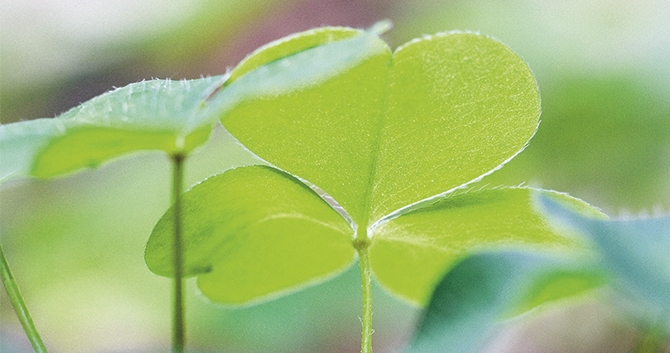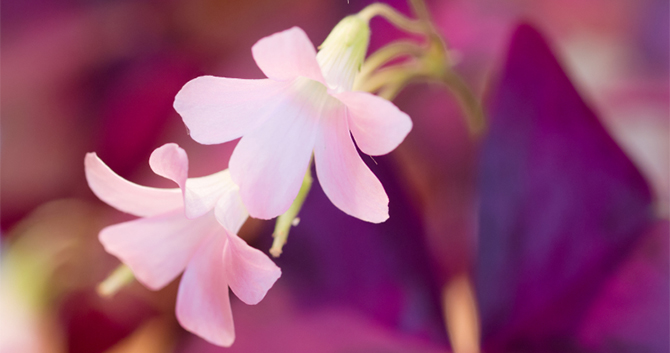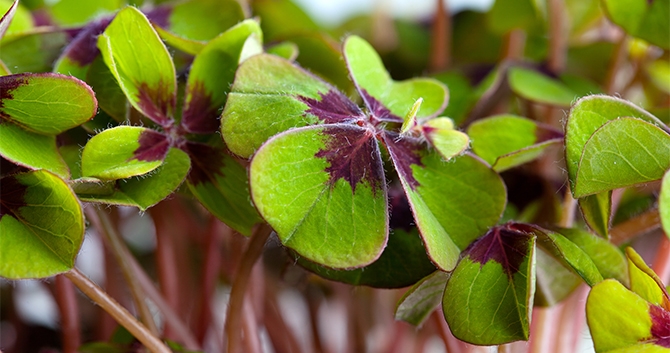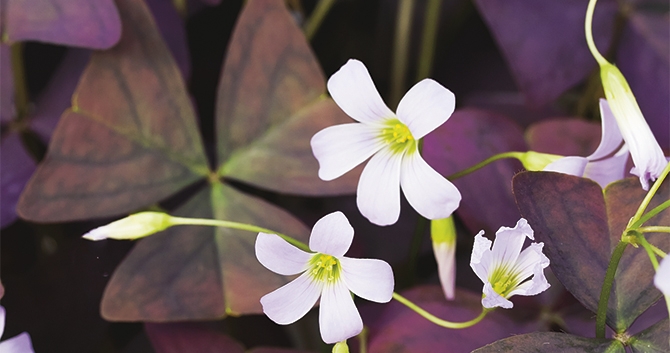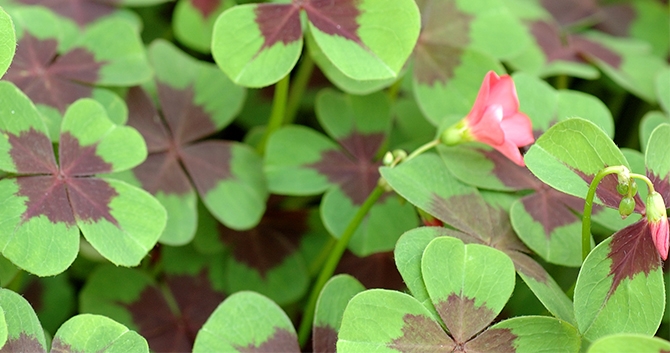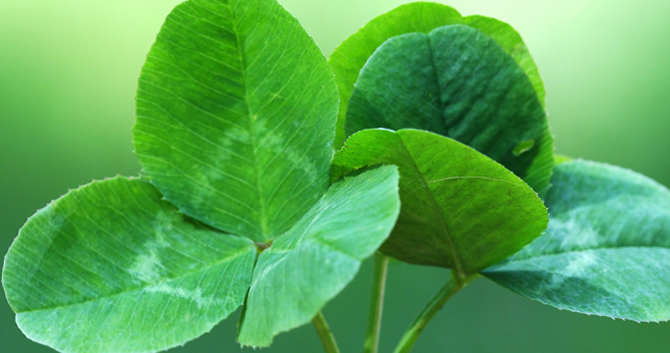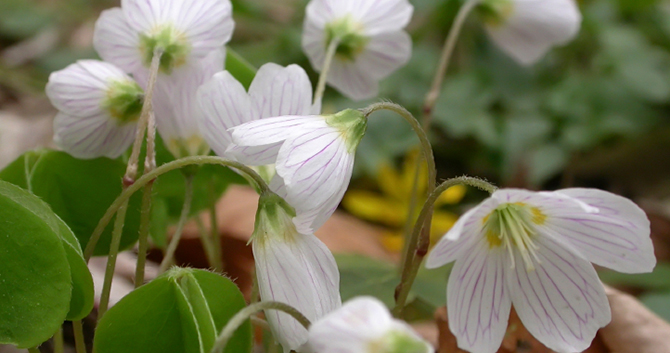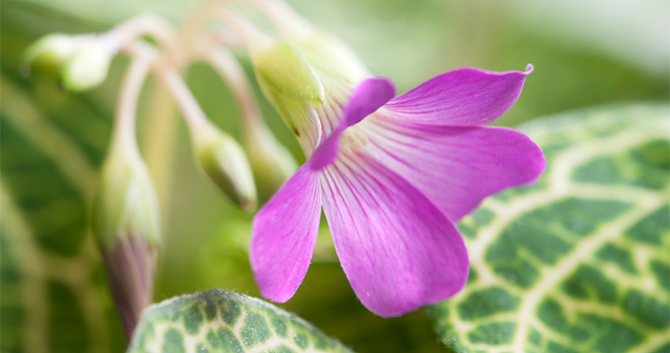Shamrocks are no longer just for St. Patrick’s Day! These charming plants add a touch of softness to any decor. When covered with dainty flowers, their sweet scent creates a feeling of tranquility.
The term shamrock comes from the Irish word seamróg, meaning “little clover”. The original shamrocks (trifolium repens or dubium) have long been emblematic of the Emerald Isle, carpeting pastures and fields with vibrant greens dappled with white blossoms.
Contrary to popular belief, what we call shamrocks (oxalis species) don’t actually hail from Ireland, but are in fact native to Mexico. These convincing look-alikes have triangular green or burgundy leaves and flowers in shades of white, pink, red and purple.
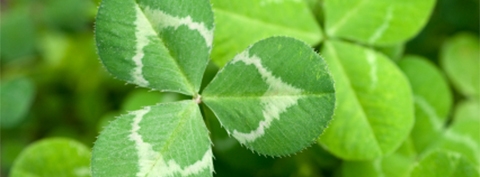 The odds of finding a four-leaf clover are said to be 1 in 10,000!
The odds of finding a four-leaf clover are said to be 1 in 10,000!
Each of the shamrock’s leaves has a unique meaning - the first symbolizes faith, the second hope, the third love, and the fourth (if you find one) - luck. The odds of finding a four-leaf clover are said to be 1 in 10,000, although there are some very lucky purple-leaved clovers that have a high percentage of four-leaf stems!
Basic Care
Shamrocks are low maintenance indoor plants – with proper care, you won’t need luck to see them bloom several times per year!
Light: Shamrocks prefer bright indirect light – near a window would be best. Just be sure your plant doesn’t touch the window as the heat can scorch the leaves.
Water: The soil should be kept consistently moist, but not soggy. Let the soil dry out slightly between waterings and pour out any water that accumulates in the pot’s saucer.
Fertilizer: To keep your shamrock as healthy as possible, fertilize regularly when it’s actively growing and blooming. Use an all-purpose liquid fertilizer formulated for indoor flowering plants, and mix and apply according to the directions.
Shamrocks are bulb plants that often go through a dormancy period, usually in fall, but potentially any time of the year if conditions are right. If you notice your shamrock losing its leaves and appear to be dying, don’t throw it out!
When the leaves begin turning brown and dying back, pull them off, reduce watering, and stop fertilizing. Place your shamrock in a cool, dark, dry place for at least a month, and as long as two or three months. It won’t need much water, but continue to check it and water when the soil begins to pull away from the side of the pot.
After its rest, return your shamrock to its display location and resume regular watering. When the leaves begin to unfold, resume the fertilizing schedule to jump start the new growth.
Repotting
The ideal time to repot your shamrock is just before you waken it from its dormancy. Repotting shamrocks every year gives them a fresh start and improves their overall health. It’s a simple process:
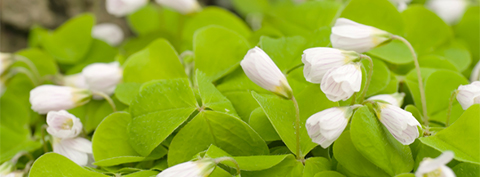 Oxalis is a Greek word meaning sour. Some species are edible, and leaves have a strong lemony flavor.
Oxalis is a Greek word meaning sour. Some species are edible, and leaves have a strong lemony flavor.
- Start by choosing a new container, making sure it’s no more than an inch wider than the current one.
- Fill the new container with about two to three inches of potting soil.
- Remove your shamrock from the current pot by placing your hand over the surface of the soil and turning it upside-down. Tap the bottom of the pot firmly with your free hand. The plant should come out easily, but give it a slight tug if needed.
- Place the root ball of the plant into the new container.
- Add more soil around the root ball to fill the container, pressing it gently down with your fingers.
- Water well to settle the soil.
Planting Outdoors
Most shamrock varieties are not hardy in most regions and are grown as indoor plants or outdoor annuals. If you’d like to grow your shamrock for the summer, simply transplant it outdoors when temperatures have warmed and danger of frost is passed.
Shamrocks prefer a spot in partial to full sun, and a moist, well-drained soil. Just remember to bring your shamrock back inside when the weather turns cold in fall, unless you live in a warm-winter climate.
Trouble Shooting:
Shamrocks are low maintenance plants and are generally trouble-free. However, as with any plant, there is the potential to run into some challenges. The most common problems involve too much or too little water.
If the leaves are wilting, your shamrock may not be getting enough water. Poke your finger about a half inch into the soil. If it feels dry, water thoroughly and increase the frequency of watering if necessary.
Yellow leaves are sign that your shamrock is overwatered. Water less frequently and your plant should rebound. It helps to check first, rather than water on a strict schedule.
If the leaves continue to yellow and drop, the plant may have root rot. Don’t panic, there is a solution! You’ll need to clean and repot the plant. Remove the shamrock from its container, and then gently loosen away the soil from the cluster of bulbs. Rinse the bulbs and roots under room temperature water, and trim away any brown or mushy roots with gardening scissors. Apply a fungicide product to the remaining roots, following package instructions, and re-plant the shamrock in a clean container.

